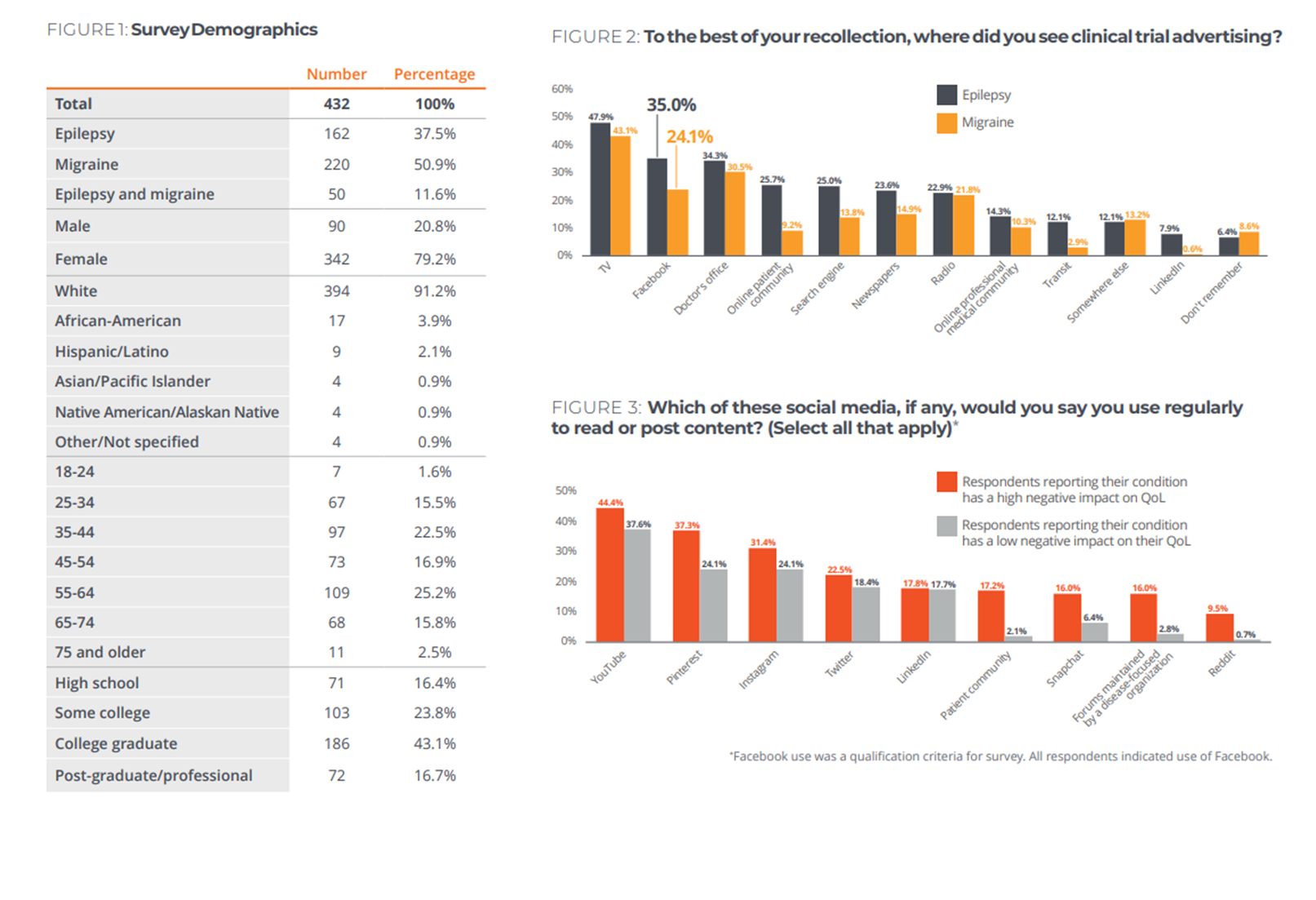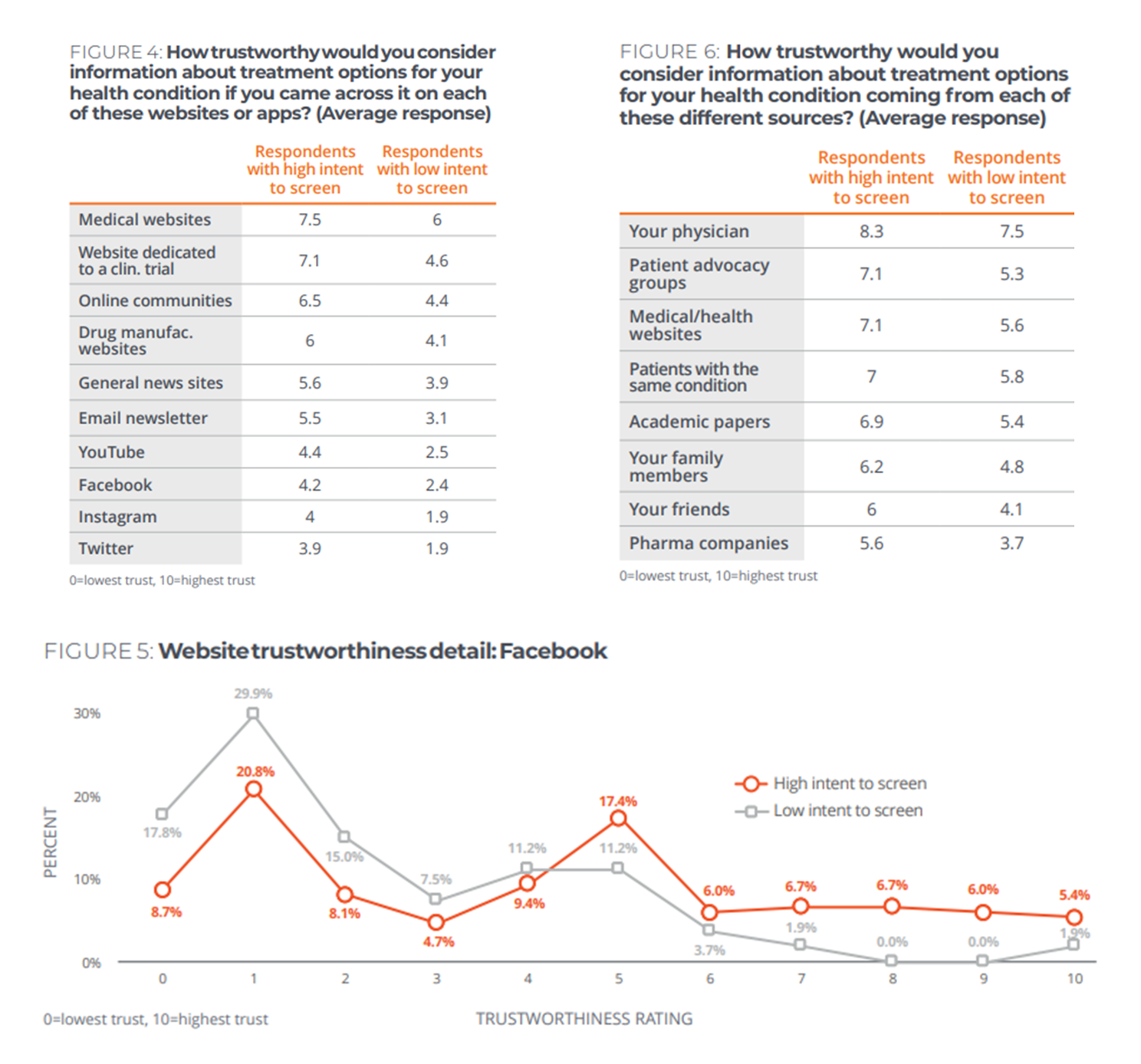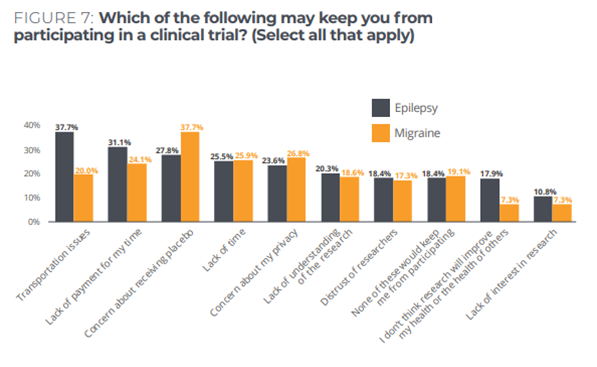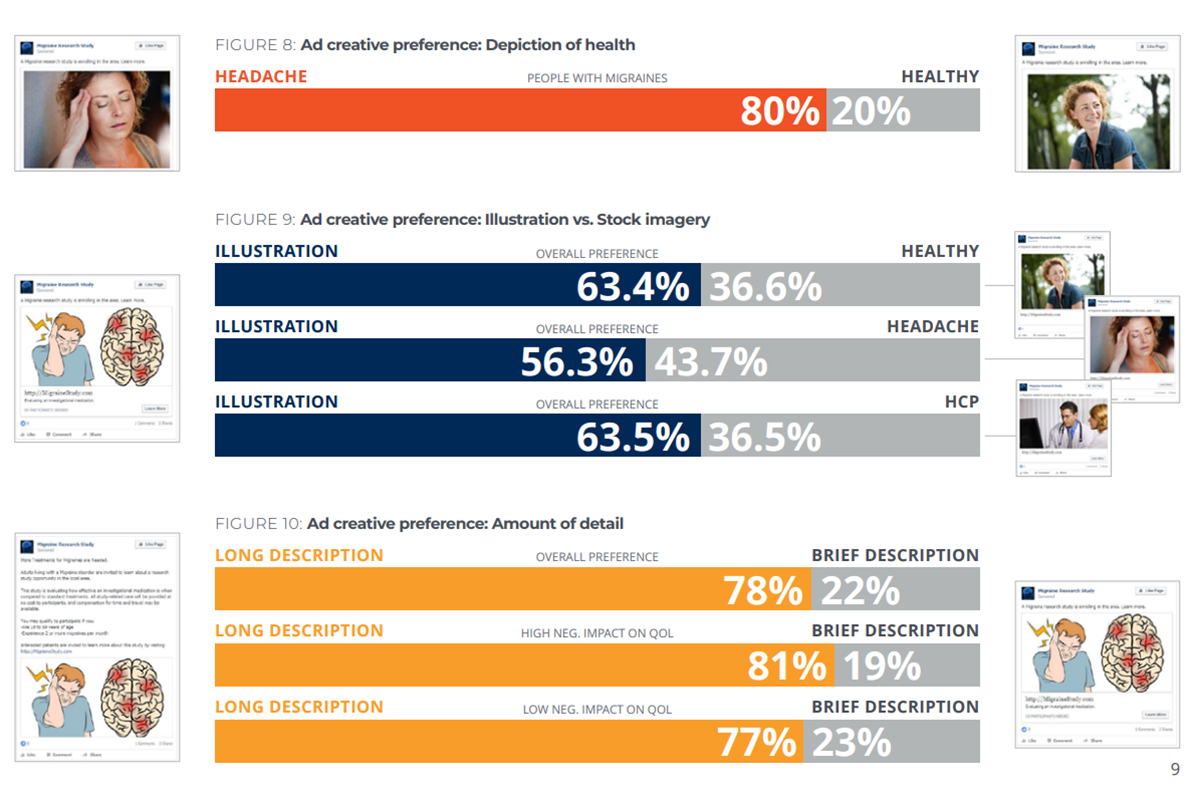Introduction
Clinical trials are a high-stakes endeavor for all parties. For pharmaceutical and biotech companies, they represent a huge investment geared toward bringing treatments to market that can alter the course of a disease. For people enrolling in clinical trials, they represent a new – and sometimes last – hope for meaningful change in disease progression. Although people have a need for trials, and trials have a need for participants, all too often they fail to connect: nearly half of all clinical trial sites fail to fully enroll.1
Increasingly, search and social marketing have taken on an important role in clinical trial patient recruitment. With 75 percent of Americans looking up medical-related information online at least monthly, it makes sense to provide clinical trial information online.2 From a sponsor’s perspective, search and social marketing offer more granular targeting capabilities, efficient pricing for ad delivery, and variability in creative execution than traditional forms of marketing. But with just 11 percent of clinical trials currently using social media to recruit participants,3 there is huge room for growth.
At Syneos Health Communications, we set out to better understand what potential research participants think of receiving clinical trial advertising online, how much they trust different online delivery channels, and what messaging and design elements help motivate potential research participants to notice and click on social media advertisements that lead them toward enrollment in a clinical trial. According to the Clinical Trials Transformation Initiative’s Recommendations on Efficient and Effective Clinical Trial Recruitment,“ by developing more engaging messages deployed through the right channels, it is possible to gain the attention of the right target audiences4 .” In our research, we sought to deepen this insight by searching within the word of social marketing for what those channels are and what those messages should be.
1. Tufts Center for the Study of Drug Development Impact Report January/ February 2013 https://static1.squarespace.com/ static/5a9eb0c8e2ccd1158288d8dc/t/5aa2c29e4192023932fec8 9d/1520616094463/02+-+Jan+15%2C+2013+-+Recruitment-Retention.pdf
2. Consumer Health Online: 2017 Research Report https://get.health/blog/ research17/
3. Tufts Center for the Study of Drug Development Impact Report March/ April 2014 https://static1.squarespace.com/ static/5a9eb0c8e2ccd1158288d8dc/t/5aa2c0b953450a076cf df621/1520615609748/PR-MARAPR14.pdf
4. CTTI Recommendations on Efficient and Effective Clinical Trial Recruitment https://www.ctti-clinicaltrials.org/projects/recruitment
The Research:
To get to the bottom of content effectiveness, in September 2018 we surveyed 432 potential clinical trial participants in the United States. To ensure we were examining a relevant target audience, we limited the survey to people who have searched for health information online and use Facebook. In order to isolate how particular health conditions could impact people’s responses to content (i.e., likelihood of clicking on ads), we limited our survey to two conditions where researchers are actively recruiting participants for promising drug studies – epilepsy and migraine [Figure 1]. Survey respondents were asked demographic information; general questions about their health condition and the impact it has on their quality of life; their awareness of clinical trials; and their trust in various online channels of information. They were also shown different forms of mock promotional materials for their condition and asked which they’d be more likely to click on for more information about a trial. From there, the results were tabulated three different ways: by condition, by intent to join a clinical trial (170 respondents indicated a high intent to join a trial, 126 indicated a low intent), and by the self-reported impact their condition has on their overall quality of life (169 respondents indicated their condition had a high negative impact on their quality of life, 141 indicated it a low negative impact). Among our survey respondents, 60 percent indicated they are familiar with clinical trials, and 16.7 percent self-reported they had participated in a clinical trial before (16 percent for epilepsy, 17.3 percent for migraine).
Reaching the Right People
For clinical trial sponsors who are hesitant to invest in social media channels, our survey returned some encouraging results. Among places where people are seeing clinical trial advertising, Facebook ranked as the second most-recalled medium for people with epilepsy, trailing only behind television. For people with migraines Facebook ranked third, after television and doctor’s office [Figure 2]. Furthermore, the people who are most apt to benefit from clinical research appeared to be the easiest to reach online. Those who indicated their disease had a high negative impact on their quality of life used social media more [Figure 3] and had a higher recall of trial ads on social media than those saying their condition had a low impact on their quality of life. It stands to reason that people who are more negatively impacted by their condition would be more engaged with their health and more willing to seek options for treatment.
Although pinpointing individuals who have a quality of life that has been severely impacted may help recruitment efforts, improved ad targeting alone is not enough to boost enrollment. In October 2018, clinicaltrials.gov listed 71 active migraine trials and 146 trials for epilepsy. The sheer competitiveness among sponsors for participants creates a major challenge that underlines the need for ad creative that will truly capture your audience’s attention.
Maximizing Trust
Because clinical trials expose participants to new, unfamiliar treatments, trust in the sponsor and investigators is essential, and advertising decisions should be made to maximize trust. In our survey, we explored people’s levels of trust in different online channels and information sources. Survey respondents who indicated a high intent to enroll in a clinical trial showed higher levels of trust in every source of information. Most social media channels yielded similar levels of trust, with YouTube emerging as the most trusted among them [Figure 4].
A deeper dive into respondents’ views of Facebook as a source of clinical trial information revealed an interesting dynamic. Facebook recently endured negative publicity around user privacy following its handling of user data in the Cambridge Analytica scandal. Sixty percent of our respondents were familiar with this event and overwhelmingly said it negatively impacted their view of the platform. Correspondingly, we saw large numbers of respondents express distrust of Facebook advertising as a source of clinical trial information across all cuts of our data.
Yet, among respondents who indicated they would be more likely to join a trial (high intent to screen) , we still observed a high percentage that viewed Facebook, overall, as a trustworthy source of information [Figure 5]. One interpretation of this dynamic is that people with a high need to communicate and get information about their condition might be angry or disappointed with Facebook, yet they still depend on it and continue to use the platform. This suggests that despite decreased confidence in the platform, Facebook remains an effective means for recruiting participants for clinical trials.
It was not surprising to see that healthcare professionals were viewed as the most trustworthy source of information in our survey [Figure 6]. This high level of trust may even impact participants’ likelihood of clicking on a clinical trial ad. When shown content that included a doctor in a white lab coat versus content that included a person in discomfort, a happy person or a person in a family setting, respondents preferred the content featuring the physician in all cases. Though we rarely hear the advice “use a stock photo of a doctor” as content creation guidance, when the issue of trust is at hand, this may actually be an effective choice.
Knowing the Audience
Many companies use a patient journey map to understand how a patient progresses through a condition and to map out communication opportunities. While this is a useful exercise, it may not be at a level deep enough to completely inform content creation. By employing a survey, we were able to uncover distinct needs, preferences, and characteristics of our audience that would help shape the messaging and channel strategies tailored specifically to address them.
For example, in our survey, epilepsy patients cited “transportation issues” and “lack of payment for my time” as the biggest barriers to participation in clinical trials; while migraine patients specifically pointed to the “concern about receiving placebo” [Figure 7]. For people living with epilepsy who may not be able to drive due to their condition, highlighting how sponsors intend to solve transportation challenges would be critical. Similarly, a set of content that outlines exactly what the compensation policy is for an epilepsy clinical trial could allay those concerns. This is different from the issues of a person living with migraines. Content that educates them on the role of placebo, the probability of receiving it, or even the absence of placebo messaging may better address migraine patients’ motivations.
Understanding the way people living with a specific medical condition relate to other members of their community can also inform channel and content insights. In our survey, people living with epilepsy were more likely than those living with migraines to say they trust others with the same condition. Because of this, we would consider using content that features other epilepsy patients. It also suggests that tapping into online influencers who have built trust and credibility with the epilepsy community could be an effective strategy. Patient forums also emerged as a valuable source of information for the epilepsy respondents. These kinds of forums often facilitate authentic conversations about a person’s experience but are seldom viewed by sponsors as a source of communicating clinical trial information.
Finding the Right Emotional Message
Because we spend so much time thinking about the promise of a medicine, we often focus our advertising efforts on the possibility for a better future. This aspirational tone has its place but can miss the target by feeling unrelatable. Our research indicated that people living with migraines were more likely to click on imagery of a person who appeared to be experiencing a headache as opposed to imagery of a happy or healthy person [Figure 8]. This suggests that people with migraines identified with the content on a personal level, and content that is too aspirational may feel disconnected. Though our findings are limited to clinical trial advertising, future research should test this insight across the spectrum of healthcare advertising. Creative executions featuring happy people are common in our industry, but perhaps in some cases authenticity and empathy for current suffering would perform better.
This principle of identification can also apply to an art director’s decision between the use of stock photography or illustrations. We found that illustrations outperformed stock photography [Figure 9]. This could be because photography requires the user to identify with a specific, real person in the photo. If you do not relate to the person in the photo, you may struggle to identify with that piece of advertising. However, an illustration may give the user the ability to more easily relate because they have the freedom to interpret the imagery as they see fit, independent of race, gender, or age.
Although an Institutional Review Board (IRB) or Ethics Committee (EC) may constrain the ability to experiment with ad creative, it is worth submitting a variety of content for review and testing multiple versions of copy and images to see what resonates best with your audience.
Headline
When TMI is Actually the Right Amount
Given ever-shorter attention spans and small screen sizes, “shorter is better” has become a maxim of online advertising. But when we showed survey participants two variations of a clinical trial ad — one with a brief description and one with a longer, more thorough description — there was a strong preference for the longer version [Figure 10]. The difference was even more pronounced for those who indicated their condition has a high negative impact on their quality of life. In that group, 81 percent preferred the ad with longer, more detailed copy. While it is tempting to always push for shorter content in the name of brevity, that may not yield the best results in a complex healthcare landscape. In some instances, more in-depth content may be needed to provide context to a person seeking detailed information about treatment options. We aren’t selling potato chips; we are asking people to make a significant commitment, so they may want more information before moving forward.
Conclusion: It's Personal
Social marketing’s creative flexibility and high degree of targeting make it a powerful tool well suited to the complexity of clinical trial recruitment. As the worlds of patient recruitment and social marketing become increasingly intertwined, it is essential for sponsors and agencies to invest time in deeply understanding their audience’s needs. Targeting the right audience, with the right messaging on the right channels can make a meaningful difference in your patient recruitment, potentially speeding up the delivery of new treatments. What are “the right” choices here? The answers will be different for every condition and every trial. But as our experience has shown, starting with careful listening can lead to the discovery of deep audience insights that truly drive strategy.
Authors
Julian Suchman
Julian is the clinical solutions lead in Syneos Health’s Digital & Social Strategy group. His work bridging the clinical and commercial words of pharma exemplifies the mission of Syneos Health’s biopharmaceutical acceleration model.
Michael Pearlman
Michael leads digital patient engagement activities within Syneos Health’s Digital & Social Strategy group. He has over 14 years of experience in digital research methodologies and online data collection. He supports advertising program design, strategic direction and technical strategy to execute and optimize digital patient recruitment campaigns.
Ilya Vedrashko
Ilya is an innovative researcher and strategist with more than 15 years of experience in designing customer- and patient-centric solutions for healthcare marketers. At Syneos Health, Ilya manages a group that conducts primary patient and physician research and applies findings to create high-ROI strategies.
Contributors: Elizabeth Katta, Thomas Morrison, Matthew Snodgrass
Headline
About Syneos Health Communications
Syneos Health Communications is the only healthcare communications network that is part of a company on the frontlines of healthcare, with a clear view into the everyday complexities of life and health. As part of Syneos Health ™, our agencies – consisting of leading brands and experts in advertising, branding, public relations, managed markets and medical communications – are engaged in every point of influence in health, providing real-world insight into markets and audiences in ways that no other partner could.




